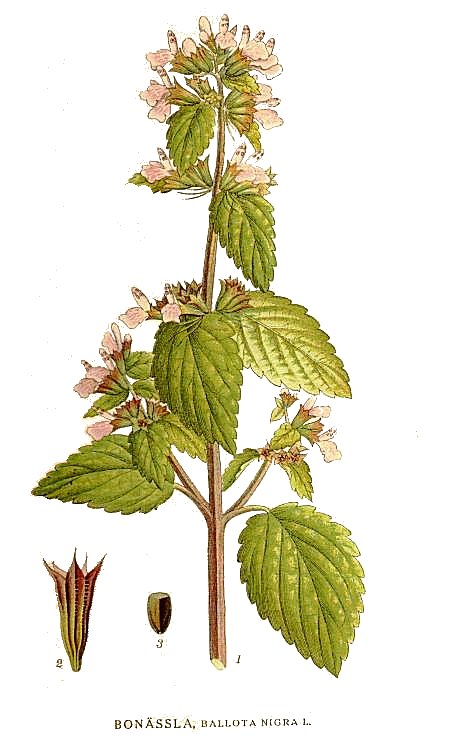Dies ist eine alte Version des Dokuments!
Lamiaceae - syn. B.alba L., B.foetida Lam., B.ballota Lutz., Marrubium nigrum Crantz.; black horehound, black hemp-nettle, stinking horehound, Schwarznessel, Anderbrume, Gottvergess, Schwarzer Andorn, Stinkandorn
Perennial herbaceous plant, 0.30-1m high, native to Europe and naturalized in eastern North America. http://eol.org/pages/579636/maps
„Mature plants take on a characteristic purplish or blackish color and a strong smell. Blallota nigra ssp.foetida, previously considered to be a distinct species (B.foetida), is the most popular form used in traditional medicine… Therapeutic category: spasmolytic, sedative.“ [MPW]
„The plant was described by Linnaeus in Species Plantarum (May 1753). The name Ballota comes from the Greek ballo (to reject), because of the strong offensive odor of the plant; cattle will not eat it. The specific name nigra could refer to the black colour of dried leaves…
The common name comes from the Old English words har, meaning „downy or hoary“, and hune, meaning the plant itself. This name refers to the hairs that give the herb its distinctive appearance. In modern times, alternative medicine practitioners have referred to the plant as „seed of Horus“ and suggested that horehound takes its name from Horus, the Egyptian sun god…
Ballota nigra is a nitrophilous plant; it grows in ruins, fallows and hedges, up to 1300 m.“ http://en.wikipedia.org/wiki/Ballota_nigra
Used in folk medicine as mild sedative for spasmodic cough, nervousness, and mild insomnia. http://de.wikipedia.org/wiki/Schwarznessel
The plant contains diterpenoid alkaloids of the labdan type: Ballotinone (7-oxomarrubiin), ballotenol, and 7α-acetoxymarrubiin.
[The structure of ballotenol, a new diterpenoid from Ballota nigra. Giuseppe Savona, Franco Piozzi, James R. Hanson and Michael Siverns, J. Chem. Soc., Perkin Trans. 1, 1977, 497-499]
[Structures of three new diterpenoids from Ballota species. Giuseppe Savona, Franco Piozzi, James R. Hanson and Michael Siverns, J. Chem. Soc., Perkin Trans. 1, 1977, 322-324]
„The chemical composition of essential oils obtained from the roots, stems, and leaves of Ballota nigra, growing in Serbia, was investigated by gas chromatography/mass spectrometry analyses. Kovats indices, mass spectra, and standard compounds were used to identify a total of 115 individual compounds. The plant produces two types of essential oils. Oils derived from stems and leaves were sesquiterpene rich (78.17% and 88.40%, respectively), containing principally β-caryophyllene, germacrene D, and α-humulene, present in appreciable amounts. In contrast, oil derived from the root was dominated by p-vinylguiacol (9.24%), borneol (7.51%), myrtenol (7.13%), trans-pinocarveol (5.22%), pinocarvone (4.37%), 2-methyl-3-phenylpropanal (4.32%), and p-cymen-8-ol (4.30%).“ [Antimicrobial Activity of the Essential Oil Obtained from Roots and Chemical Composition of the Volatile Constituents from the Roots, Stems, and Leaves of Ballota nigra from Serbia, Nenad Vukovic, Slobodan Sukdolak, Slavica Solujic, and Neda Niciforovic. Journal of Medicinal Food. April 2009, 12(2): 435-441]

